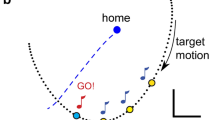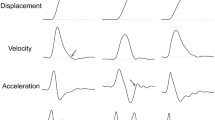Abstract
Complex limb movements exhibit segmentation into submovements characterized as bell-shaped speed pulses. Submovements have been implicated in both feedback and feedforward control, reflecting an intermittent error-correction process. This study examines submovements occurring during a circular manual tracking task in humans, focusing on the amplitude-duration scaling of submovements and the properties of this scaling across changes in movement speed and external force load. The task consisted of intercepting and tracking a circularly moving target using a two-jointed, robotic arm that allowed external force fields to be imposed during tracking. Different speed levels and different levels of three types of force field were examined. Submovements were defined as fluctuations in the speed profile. The properties of the amplitude-duration ratio of the speed pulses were examined in relation to target speed and external force fields. The results show that the amplitude and duration of the submovements scale linearly in human manual tracking. The slope of the scaling was independently influenced by both target speed and external force fields. A common element in the increase in the scaling slope was increased tracking errors. Control experiments using passive movements and power spectral analysis showed that the submovements were not artifacts of the mechanical/acquisition system or the imposed force field. These results are consistent with the concept of stereotypy in which movements are constructed of scaled versions of a single prototype. Furthermore, the results support the hypothesis that submovements are integral to an error detection and correction control process.












Similar content being viewed by others
References
Abend W, Bizzi E, Morasso P (1982) Human arm trajectory formation. Brain 105:331–348
Beggs WDA, Howarth CD (1970) Movement control in man in a repetitive motor task. Nature 221:1247–1257
Berthier NE (1997) Predictive reaching for moving objects by human infants. In: Donahue J, Dorsal VP (eds) Neural network models of complex behavior—biobehavioral foundations. North Holland, Amsterdam, pp 283–301
Brooks VB, Kozlovskaya IB, Atkin A, Horvath FE, Uno M (1973) Effects of cooling denate nucleus on tracking-task performance in monkeys. J Neurophysiol 36:974–995
Burdet E, Milner T (1998) Quantization of human motions and learning of accurate movements. Biol Cybern 78:307–318
Doeringer JA, Hogan H (1998) Intermittency in preplanned elbow movements persists in the absence of visual feedback. J Neurophysiol 80:1787–1799
Fitts PM (1954) The information capacity of the human motor system in controlling the amplitude of movement. J Exp Psychol 47:381–391
Flash T, Henis E (1991) Arm trajectory modifications during reaching towards visual targets. J Cogn Neurosci 3:220–230
Flash T, Hogan N (1985) The coordination of arm movements: an experimentally confirmed mathematical model. J Neurosci 5:1688–1703
Hartman BO, Fitts PM (1955) Relation of stimulus and response amplitude to tracking performance. J Exp Psychol 49:82–92
Hick WE (1948) The discontinuous functioning of the human operator in pursuit tasks. Quart J Exp Psychol 1:36–51
Hogan N (1985) The mechanics of multi-joint posture and movement control. Biol Cybern 52:315–331
Keele SW, Posner MI (1968) Processing of visual feedback in rapid movements. J Exp Psychol 77:155–158
Lacquaniti F, Soechting JF (1982) Coordination of arm and wrist motion during a reaching task. Neuroscience 2:399–408
Lee D, Port NL, Georgopoulos AP (1997) Manual interception of moving targets. II. On-line control of overlapping submovements. Exp Brain Res 116:421–433
Massey JT, Lurito JT, Pellizzer G, Georgopoulos AP (1992) Three-dimensional drawings in isometric conditions: relation between geometry and kinematics. Exp Brain Res 88:685–690
Meyer DE, Smith JE, Wright CE (1982) Models for the speed and accuracy of aimed movements. Psychol Rev 89:449–482
Miall RC, Weir DJ, Stein J (1986) Manual tracking of visual targets by trained monkeys. Behav Brain Res 20:185–201
Milner TE (1992) A model for the generation of movements requiring endpoint precision. Neuroscience 49:487–496
Milner TE, Ijaz MM (1990) The effect of accuracy constraints on three-dimensional movement kinematics. Neuroscience 35:365–374
Morasso P (1981) Spatial control of arm movements. Exp Brain Res 42:223–227
Morasso P, Mussa-Ivaldi F (1982) Trajectory formation and handwriting: a computational model. Biol Cybern 45:131–142
Noble M, Fitts PM, Warren CE (1954) The frequency response of skilled subjects in a pursuit tracking task. J Exp Psychol 49:249–259
Novak KE, Miller LE, Houk JC (2000) Kinematic properties of rapid hand movements in a knob turning task. Exp Brain Res 132:419–433
Novak KE, Miller LE, Houk JC (2002) The use of overlapping submovements in the control of rapid hand movements. Exp Brain Res 144:351–364
Rohrer B, Hogan N (2003) Avoiding spurious submovement decompositions: a globally optimal algorithm. Biol Cybern 89:190–199
Roitman AV, Pasalar S, Ebner TJ (2003) Force field and speed effect on submovements during circular manual tracking in human. Program No. 492.5. 2003 Abstract Viewer/Itinerary Planner. Washington, DC: Society for Neuroscience. Online.
Roitman AV, Massaquoi SG, Takahashi K, Ebner TJ (2004a) Kinematic analysis of manual tracking in monkeys: characterization of movement intermittencies during a circular tracking task. J Neurophysiol 91:901–911
Roitman AV, Pasalar S, Ebner TJ (2004b) Purkinje cell activity is coupled to submovements and error signals during circular manual tracking in monkey. Program No. 827.1. 2004 Abstract Viewer/Itinerary Planner. Washington, DC: Society for Neuroscience. Online.
Shadmehr R, Mussa-Ivaldi FA (1994) Adaptive representation of dynamics during learning of a motor task. J Neurosci 14:3208–3224
Sternad D, Schaal S (1999) Segmentation of endpoint trajectories does not imply segmented control. Exp Brain Res 124:118–136
Vince MA (1948) Corrective movements in a pursuit task. J Exp Psychol 38:85–103
Von Hofsten C (1980) Analysis of reaching for stationary and moving objects in the human infant. J Exp Child Psychol 30:369–382
Woodworth RC (1899) The accuracy of voluntary movements. Psychol Rev Mono Suppl 3:1–114
Acknowledgments
We thank M. McPhee for assistance with graphics and S. Allison for assistance with programming. This study was supported in part by NIH grant RO1 NS18338.
Author information
Authors and Affiliations
Corresponding author
Rights and permissions
About this article
Cite this article
Pasalar, S., Roitman, A.V. & Ebner, T.J. Effects of speeds and force fields on submovements during circular manual tracking in humans. Exp Brain Res 163, 214–225 (2005). https://doi.org/10.1007/s00221-004-2169-6
Received:
Accepted:
Published:
Issue Date:
DOI: https://doi.org/10.1007/s00221-004-2169-6




